Contemporary Accounting Issues: Alumina Limited Financial Analysis
VerifiedAdded on 2023/01/19
|11
|2027
|87
Report
AI Summary
This report examines the compliance of Alumina Limited with the International Accounting Standards Board (IASB) standards, focusing on the conceptual accounting framework (CF). It analyzes the company's financial reporting, including measurement criteria, qualitative characteristics (relevance and faithful representation), and enhancing qualitative characteristics (comparability, verifiability, timeliness, and understandability). The report evaluates the users of financial reports, the knowledge required by them, and how Alumina Limited meets the requirements of general-purpose financial reporting. The analysis references Alumina Limited's annual reports and relevant accounting standards, concluding that the company effectively complies with IFRS and the CF, thereby providing useful information for investors, lenders, and creditors in their decision-making processes. The report emphasizes the importance of understanding accounting principles for effective financial analysis and decision-making.
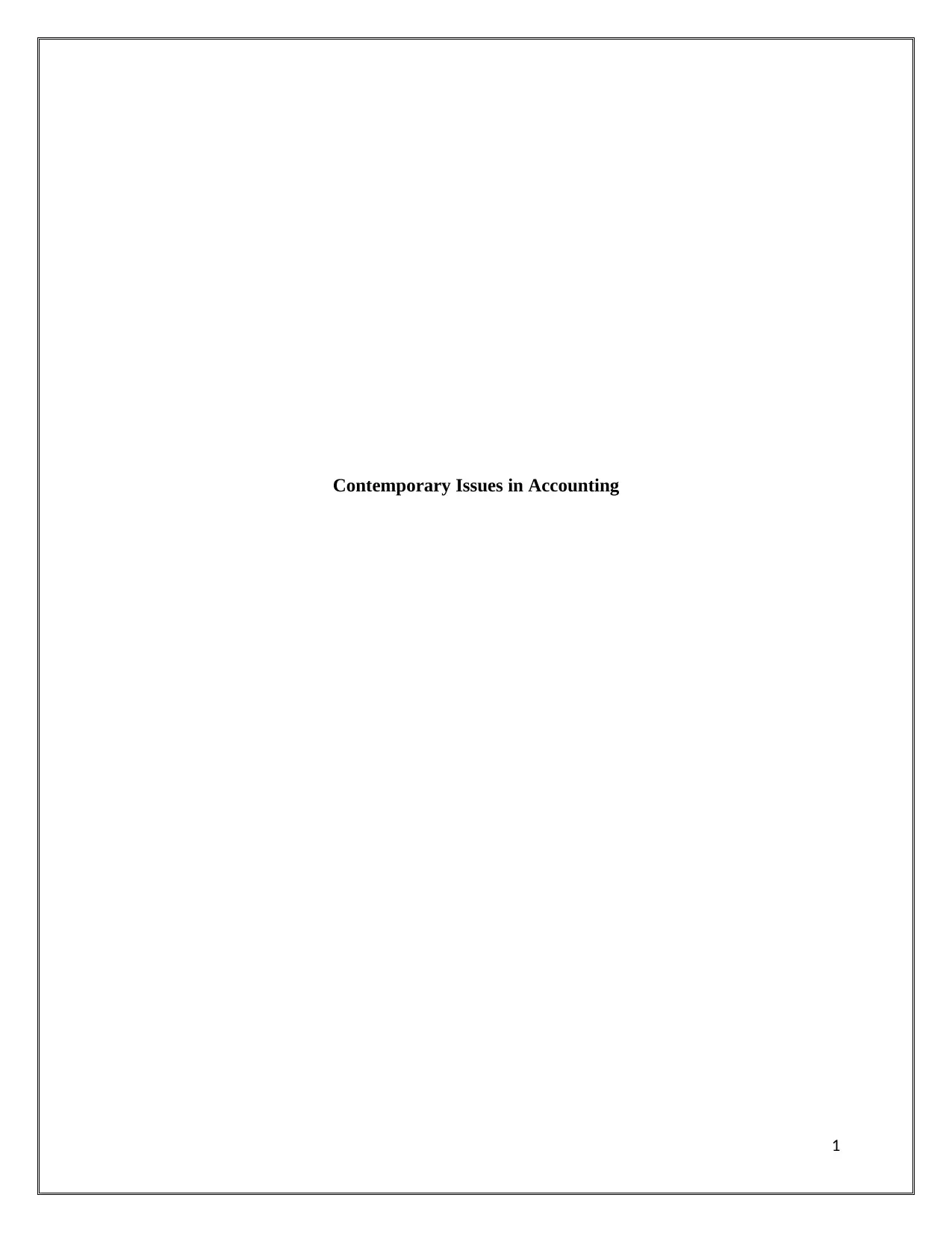
Contemporary Issues in Accounting
1
1
Paraphrase This Document
Need a fresh take? Get an instant paraphrase of this document with our AI Paraphraser
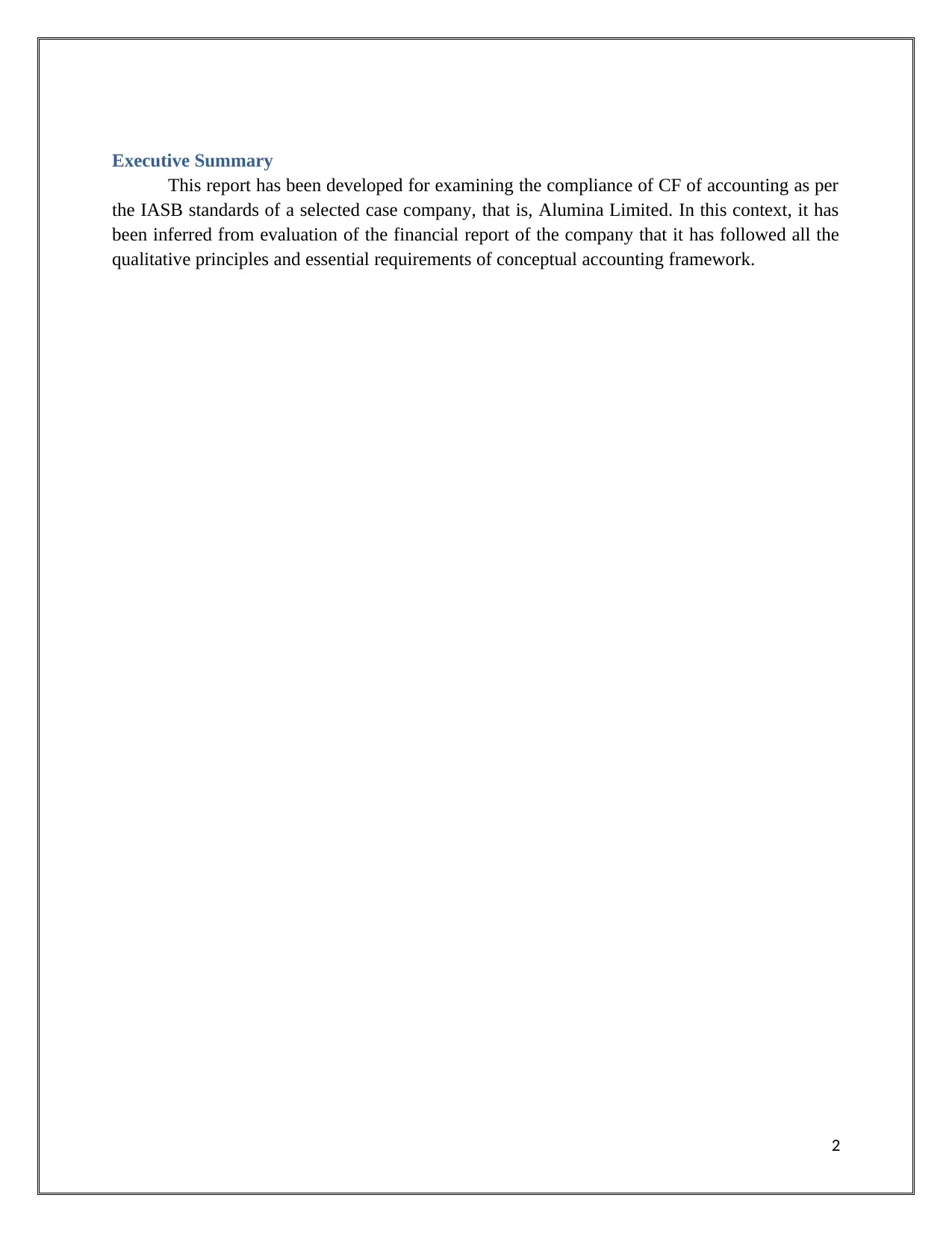
Executive Summary
This report has been developed for examining the compliance of CF of accounting as per
the IASB standards of a selected case company, that is, Alumina Limited. In this context, it has
been inferred from evaluation of the financial report of the company that it has followed all the
qualitative principles and essential requirements of conceptual accounting framework.
2
This report has been developed for examining the compliance of CF of accounting as per
the IASB standards of a selected case company, that is, Alumina Limited. In this context, it has
been inferred from evaluation of the financial report of the company that it has followed all the
qualitative principles and essential requirements of conceptual accounting framework.
2
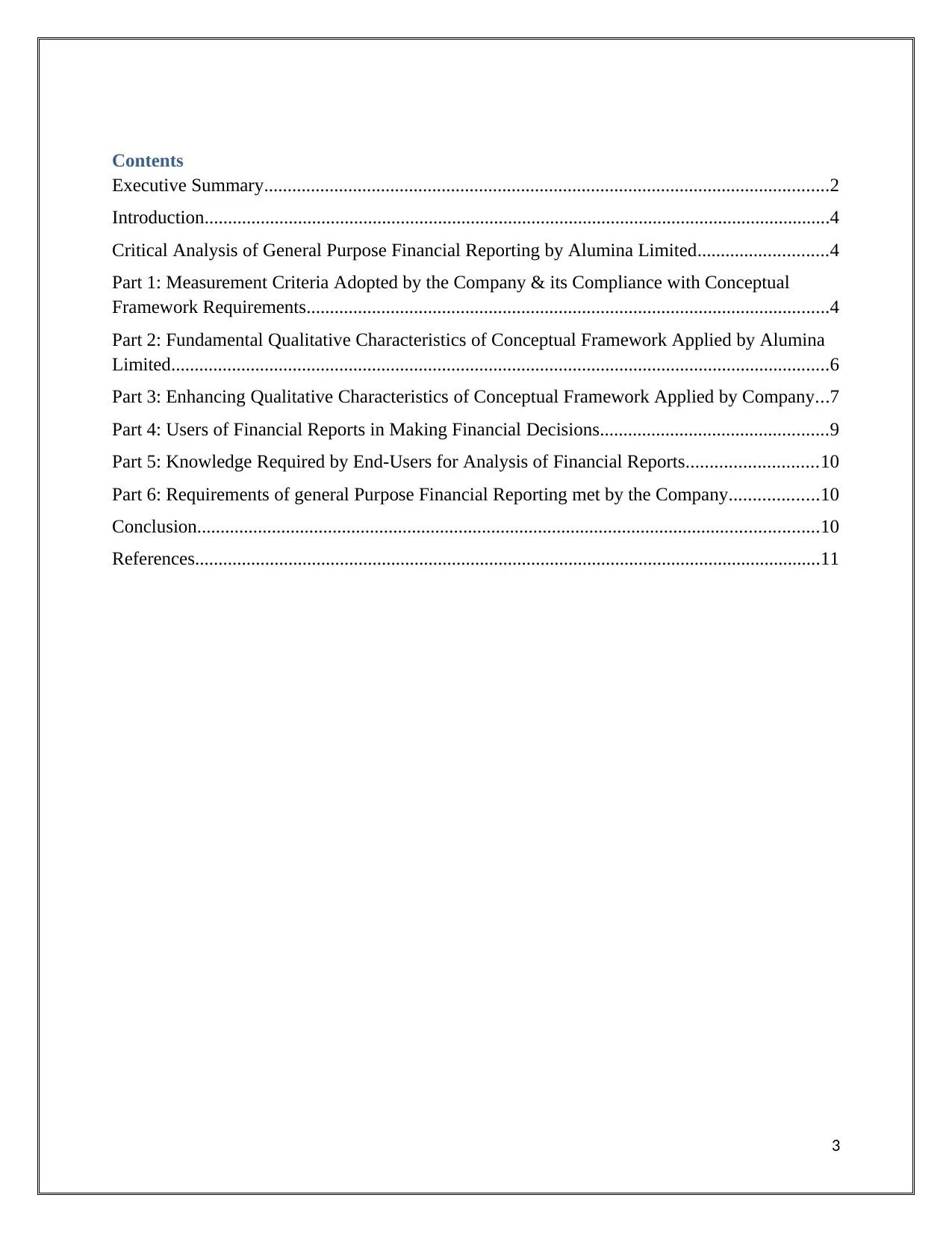
Contents
Executive Summary.........................................................................................................................2
Introduction......................................................................................................................................4
Critical Analysis of General Purpose Financial Reporting by Alumina Limited............................4
Part 1: Measurement Criteria Adopted by the Company & its Compliance with Conceptual
Framework Requirements................................................................................................................4
Part 2: Fundamental Qualitative Characteristics of Conceptual Framework Applied by Alumina
Limited.............................................................................................................................................6
Part 3: Enhancing Qualitative Characteristics of Conceptual Framework Applied by Company...7
Part 4: Users of Financial Reports in Making Financial Decisions.................................................9
Part 5: Knowledge Required by End-Users for Analysis of Financial Reports............................10
Part 6: Requirements of general Purpose Financial Reporting met by the Company...................10
Conclusion.....................................................................................................................................10
References......................................................................................................................................11
3
Executive Summary.........................................................................................................................2
Introduction......................................................................................................................................4
Critical Analysis of General Purpose Financial Reporting by Alumina Limited............................4
Part 1: Measurement Criteria Adopted by the Company & its Compliance with Conceptual
Framework Requirements................................................................................................................4
Part 2: Fundamental Qualitative Characteristics of Conceptual Framework Applied by Alumina
Limited.............................................................................................................................................6
Part 3: Enhancing Qualitative Characteristics of Conceptual Framework Applied by Company...7
Part 4: Users of Financial Reports in Making Financial Decisions.................................................9
Part 5: Knowledge Required by End-Users for Analysis of Financial Reports............................10
Part 6: Requirements of general Purpose Financial Reporting met by the Company...................10
Conclusion.....................................................................................................................................10
References......................................................................................................................................11
3
⊘ This is a preview!⊘
Do you want full access?
Subscribe today to unlock all pages.

Trusted by 1+ million students worldwide
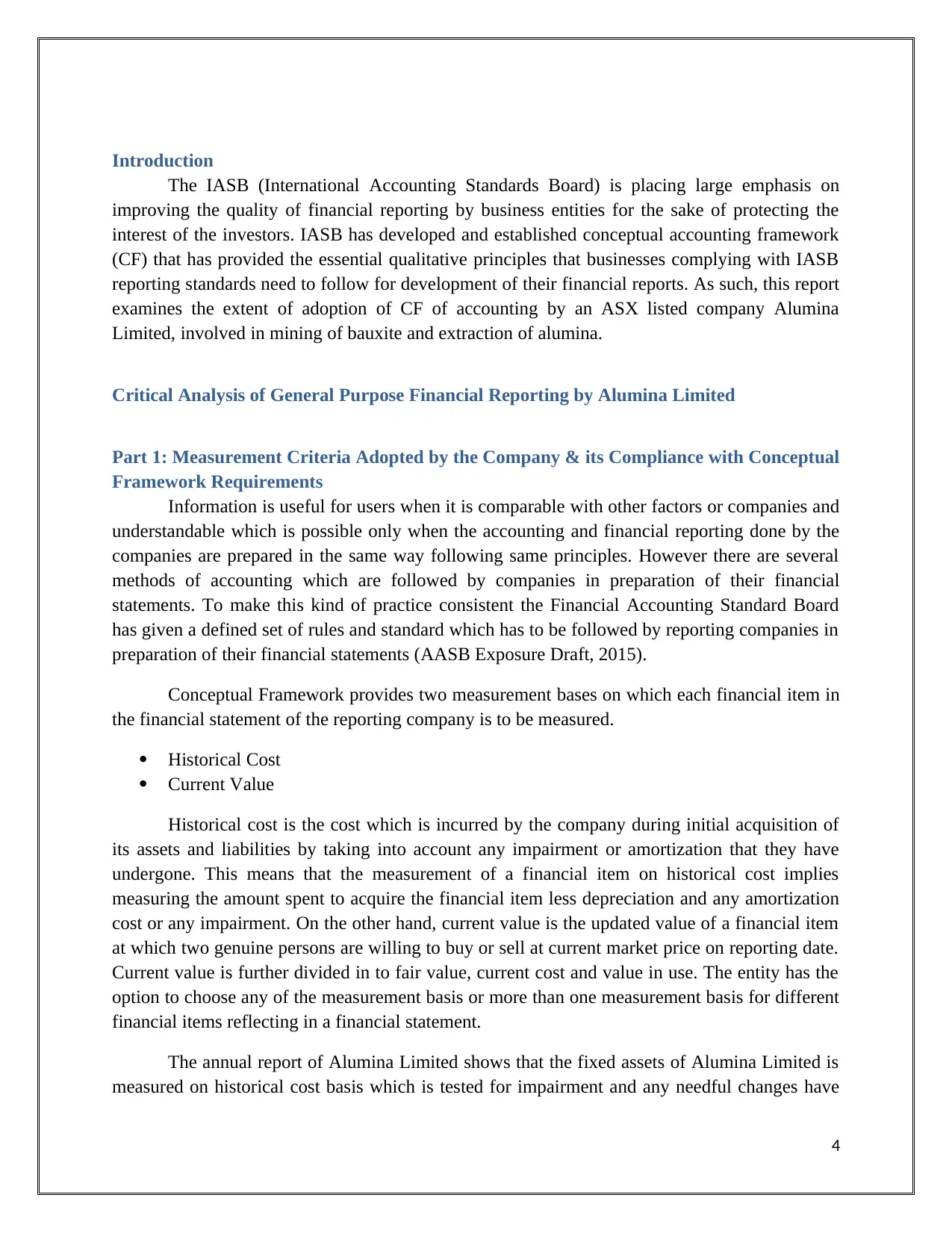
Introduction
The IASB (International Accounting Standards Board) is placing large emphasis on
improving the quality of financial reporting by business entities for the sake of protecting the
interest of the investors. IASB has developed and established conceptual accounting framework
(CF) that has provided the essential qualitative principles that businesses complying with IASB
reporting standards need to follow for development of their financial reports. As such, this report
examines the extent of adoption of CF of accounting by an ASX listed company Alumina
Limited, involved in mining of bauxite and extraction of alumina.
Critical Analysis of General Purpose Financial Reporting by Alumina Limited
Part 1: Measurement Criteria Adopted by the Company & its Compliance with Conceptual
Framework Requirements
Information is useful for users when it is comparable with other factors or companies and
understandable which is possible only when the accounting and financial reporting done by the
companies are prepared in the same way following same principles. However there are several
methods of accounting which are followed by companies in preparation of their financial
statements. To make this kind of practice consistent the Financial Accounting Standard Board
has given a defined set of rules and standard which has to be followed by reporting companies in
preparation of their financial statements (AASB Exposure Draft, 2015).
Conceptual Framework provides two measurement bases on which each financial item in
the financial statement of the reporting company is to be measured.
Historical Cost
Current Value
Historical cost is the cost which is incurred by the company during initial acquisition of
its assets and liabilities by taking into account any impairment or amortization that they have
undergone. This means that the measurement of a financial item on historical cost implies
measuring the amount spent to acquire the financial item less depreciation and any amortization
cost or any impairment. On the other hand, current value is the updated value of a financial item
at which two genuine persons are willing to buy or sell at current market price on reporting date.
Current value is further divided in to fair value, current cost and value in use. The entity has the
option to choose any of the measurement basis or more than one measurement basis for different
financial items reflecting in a financial statement.
The annual report of Alumina Limited shows that the fixed assets of Alumina Limited is
measured on historical cost basis which is tested for impairment and any needful changes have
4
The IASB (International Accounting Standards Board) is placing large emphasis on
improving the quality of financial reporting by business entities for the sake of protecting the
interest of the investors. IASB has developed and established conceptual accounting framework
(CF) that has provided the essential qualitative principles that businesses complying with IASB
reporting standards need to follow for development of their financial reports. As such, this report
examines the extent of adoption of CF of accounting by an ASX listed company Alumina
Limited, involved in mining of bauxite and extraction of alumina.
Critical Analysis of General Purpose Financial Reporting by Alumina Limited
Part 1: Measurement Criteria Adopted by the Company & its Compliance with Conceptual
Framework Requirements
Information is useful for users when it is comparable with other factors or companies and
understandable which is possible only when the accounting and financial reporting done by the
companies are prepared in the same way following same principles. However there are several
methods of accounting which are followed by companies in preparation of their financial
statements. To make this kind of practice consistent the Financial Accounting Standard Board
has given a defined set of rules and standard which has to be followed by reporting companies in
preparation of their financial statements (AASB Exposure Draft, 2015).
Conceptual Framework provides two measurement bases on which each financial item in
the financial statement of the reporting company is to be measured.
Historical Cost
Current Value
Historical cost is the cost which is incurred by the company during initial acquisition of
its assets and liabilities by taking into account any impairment or amortization that they have
undergone. This means that the measurement of a financial item on historical cost implies
measuring the amount spent to acquire the financial item less depreciation and any amortization
cost or any impairment. On the other hand, current value is the updated value of a financial item
at which two genuine persons are willing to buy or sell at current market price on reporting date.
Current value is further divided in to fair value, current cost and value in use. The entity has the
option to choose any of the measurement basis or more than one measurement basis for different
financial items reflecting in a financial statement.
The annual report of Alumina Limited shows that the fixed assets of Alumina Limited is
measured on historical cost basis which is tested for impairment and any needful changes have
4
Paraphrase This Document
Need a fresh take? Get an instant paraphrase of this document with our AI Paraphraser
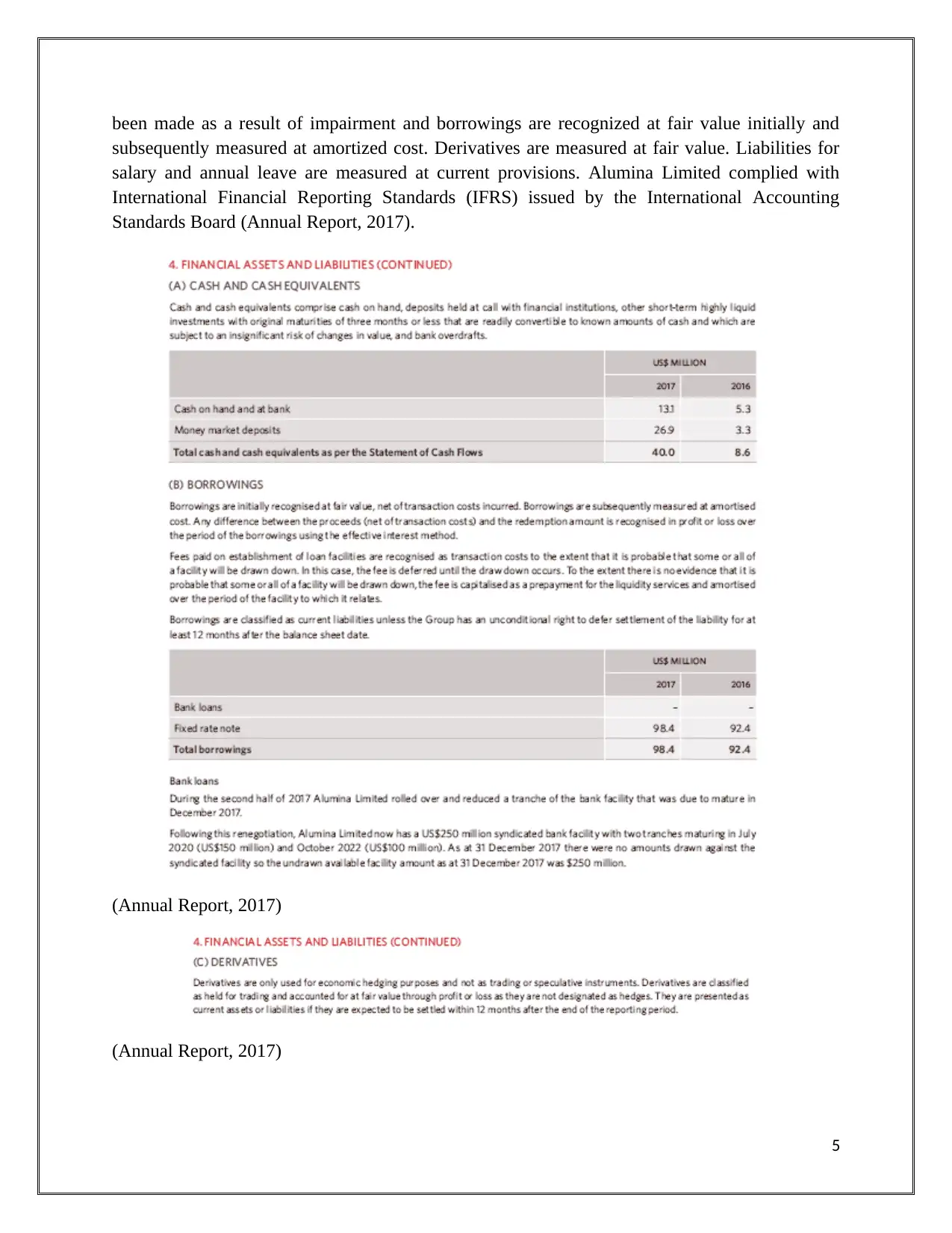
been made as a result of impairment and borrowings are recognized at fair value initially and
subsequently measured at amortized cost. Derivatives are measured at fair value. Liabilities for
salary and annual leave are measured at current provisions. Alumina Limited complied with
International Financial Reporting Standards (IFRS) issued by the International Accounting
Standards Board (Annual Report, 2017).
(Annual Report, 2017)
(Annual Report, 2017)
5
subsequently measured at amortized cost. Derivatives are measured at fair value. Liabilities for
salary and annual leave are measured at current provisions. Alumina Limited complied with
International Financial Reporting Standards (IFRS) issued by the International Accounting
Standards Board (Annual Report, 2017).
(Annual Report, 2017)
(Annual Report, 2017)
5
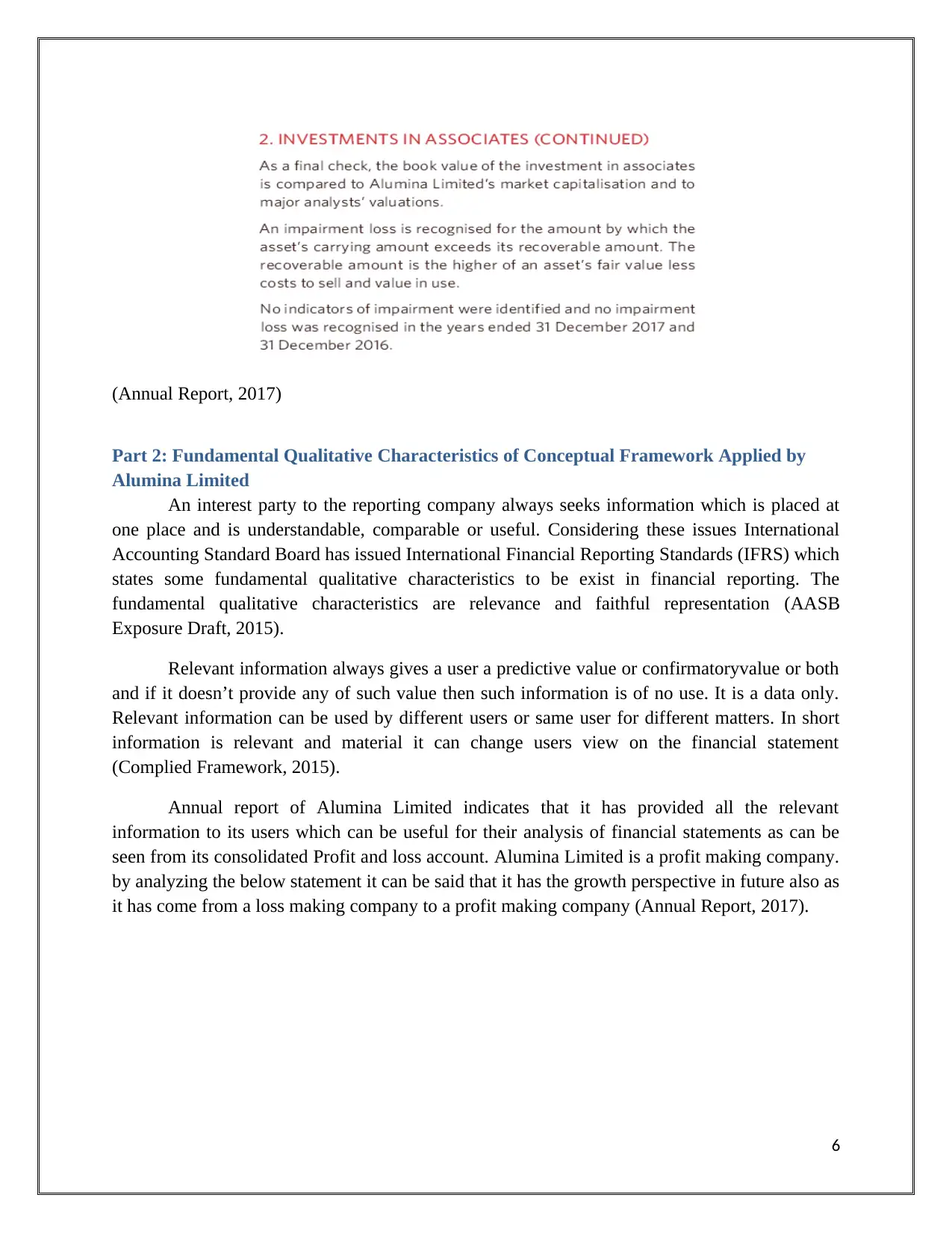
(Annual Report, 2017)
Part 2: Fundamental Qualitative Characteristics of Conceptual Framework Applied by
Alumina Limited
An interest party to the reporting company always seeks information which is placed at
one place and is understandable, comparable or useful. Considering these issues International
Accounting Standard Board has issued International Financial Reporting Standards (IFRS) which
states some fundamental qualitative characteristics to be exist in financial reporting. The
fundamental qualitative characteristics are relevance and faithful representation (AASB
Exposure Draft, 2015).
Relevant information always gives a user a predictive value or confirmatoryvalue or both
and if it doesn’t provide any of such value then such information is of no use. It is a data only.
Relevant information can be used by different users or same user for different matters. In short
information is relevant and material it can change users view on the financial statement
(Complied Framework, 2015).
Annual report of Alumina Limited indicates that it has provided all the relevant
information to its users which can be useful for their analysis of financial statements as can be
seen from its consolidated Profit and loss account. Alumina Limited is a profit making company.
by analyzing the below statement it can be said that it has the growth perspective in future also as
it has come from a loss making company to a profit making company (Annual Report, 2017).
6
Part 2: Fundamental Qualitative Characteristics of Conceptual Framework Applied by
Alumina Limited
An interest party to the reporting company always seeks information which is placed at
one place and is understandable, comparable or useful. Considering these issues International
Accounting Standard Board has issued International Financial Reporting Standards (IFRS) which
states some fundamental qualitative characteristics to be exist in financial reporting. The
fundamental qualitative characteristics are relevance and faithful representation (AASB
Exposure Draft, 2015).
Relevant information always gives a user a predictive value or confirmatoryvalue or both
and if it doesn’t provide any of such value then such information is of no use. It is a data only.
Relevant information can be used by different users or same user for different matters. In short
information is relevant and material it can change users view on the financial statement
(Complied Framework, 2015).
Annual report of Alumina Limited indicates that it has provided all the relevant
information to its users which can be useful for their analysis of financial statements as can be
seen from its consolidated Profit and loss account. Alumina Limited is a profit making company.
by analyzing the below statement it can be said that it has the growth perspective in future also as
it has come from a loss making company to a profit making company (Annual Report, 2017).
6
⊘ This is a preview!⊘
Do you want full access?
Subscribe today to unlock all pages.

Trusted by 1+ million students worldwide
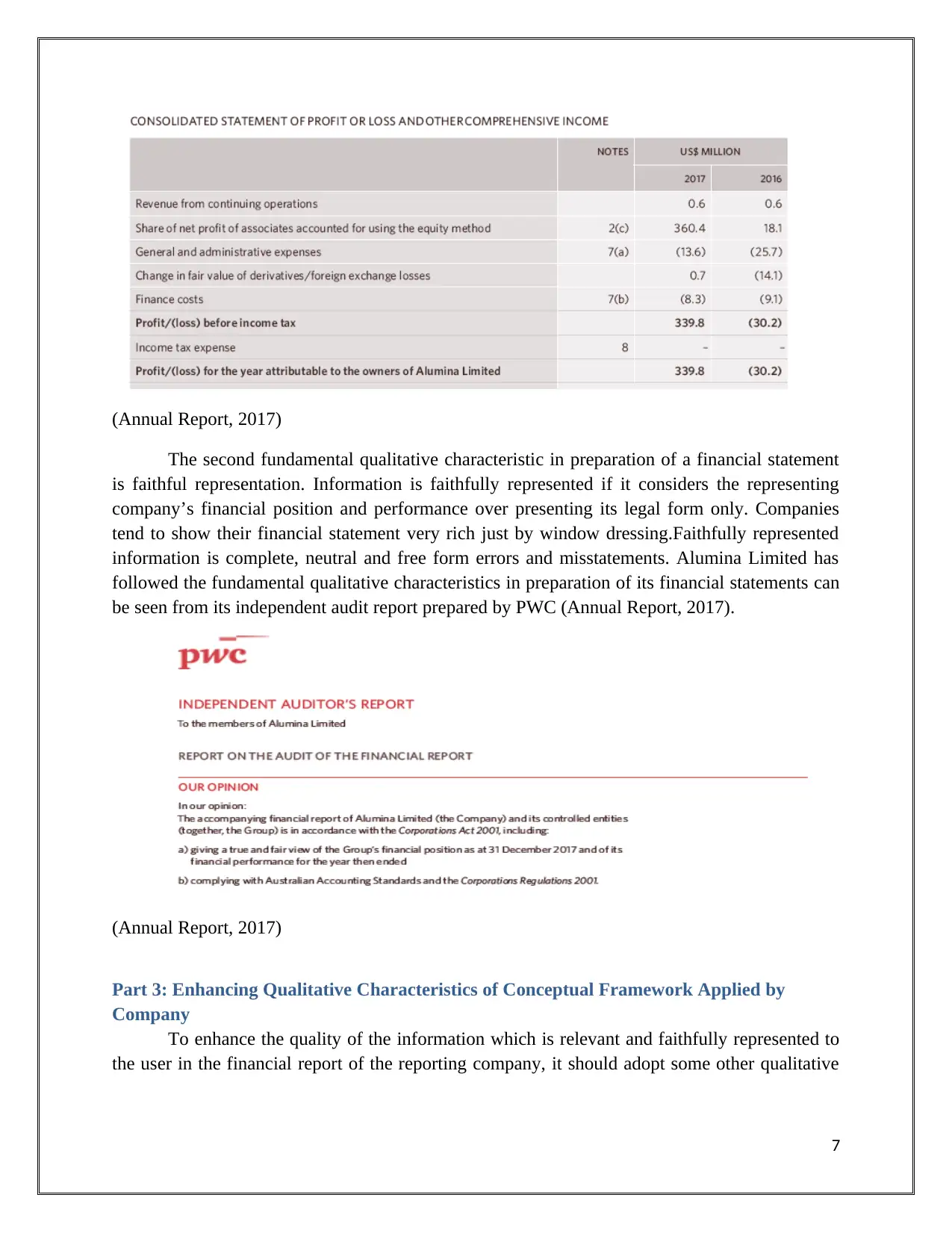
(Annual Report, 2017)
The second fundamental qualitative characteristic in preparation of a financial statement
is faithful representation. Information is faithfully represented if it considers the representing
company’s financial position and performance over presenting its legal form only. Companies
tend to show their financial statement very rich just by window dressing.Faithfully represented
information is complete, neutral and free form errors and misstatements. Alumina Limited has
followed the fundamental qualitative characteristics in preparation of its financial statements can
be seen from its independent audit report prepared by PWC (Annual Report, 2017).
(Annual Report, 2017)
Part 3: Enhancing Qualitative Characteristics of Conceptual Framework Applied by
Company
To enhance the quality of the information which is relevant and faithfully represented to
the user in the financial report of the reporting company, it should adopt some other qualitative
7
The second fundamental qualitative characteristic in preparation of a financial statement
is faithful representation. Information is faithfully represented if it considers the representing
company’s financial position and performance over presenting its legal form only. Companies
tend to show their financial statement very rich just by window dressing.Faithfully represented
information is complete, neutral and free form errors and misstatements. Alumina Limited has
followed the fundamental qualitative characteristics in preparation of its financial statements can
be seen from its independent audit report prepared by PWC (Annual Report, 2017).
(Annual Report, 2017)
Part 3: Enhancing Qualitative Characteristics of Conceptual Framework Applied by
Company
To enhance the quality of the information which is relevant and faithfully represented to
the user in the financial report of the reporting company, it should adopt some other qualitative
7
Paraphrase This Document
Need a fresh take? Get an instant paraphrase of this document with our AI Paraphraser
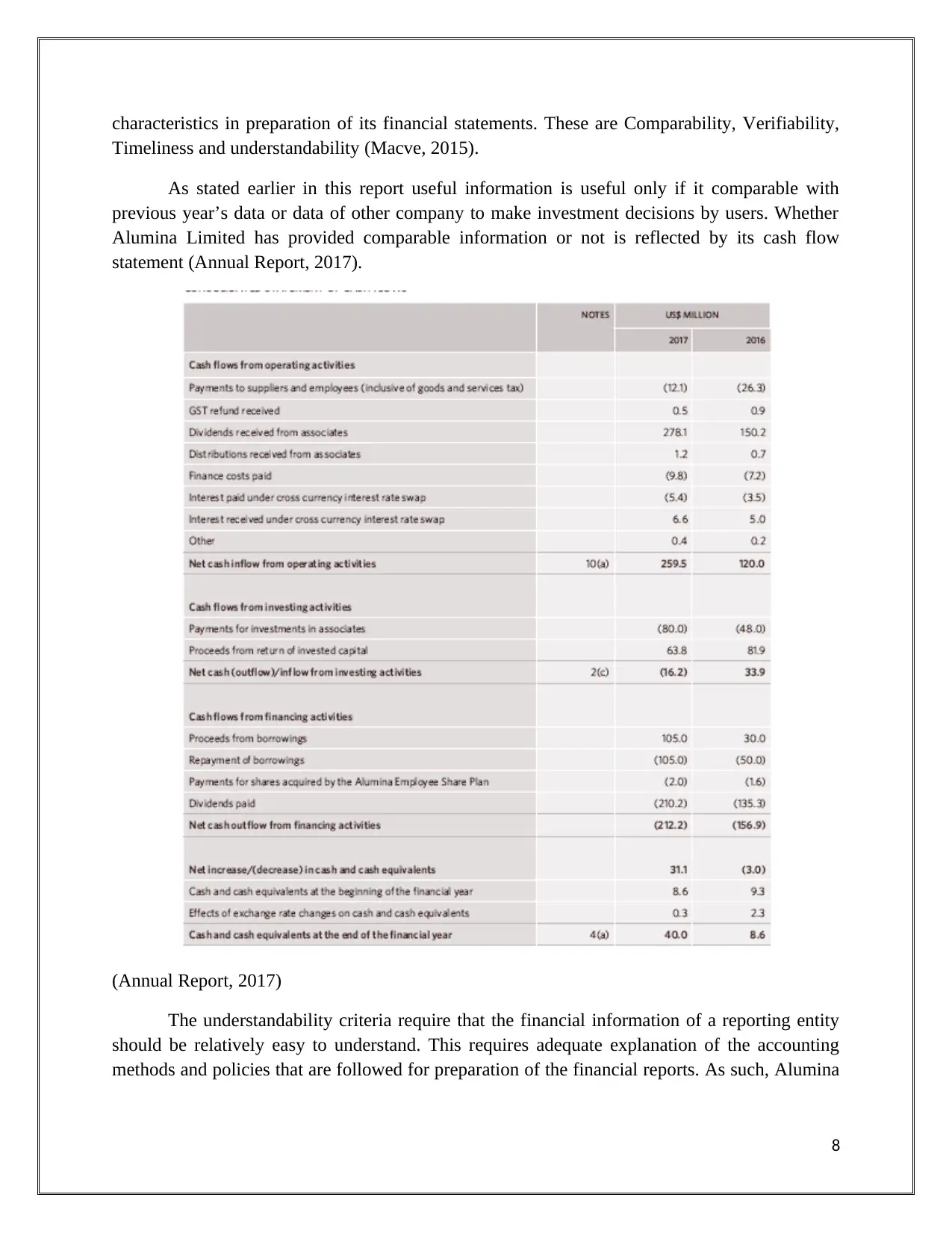
characteristics in preparation of its financial statements. These are Comparability, Verifiability,
Timeliness and understandability (Macve, 2015).
As stated earlier in this report useful information is useful only if it comparable with
previous year’s data or data of other company to make investment decisions by users. Whether
Alumina Limited has provided comparable information or not is reflected by its cash flow
statement (Annual Report, 2017).
(Annual Report, 2017)
The understandability criteria require that the financial information of a reporting entity
should be relatively easy to understand. This requires adequate explanation of the accounting
methods and policies that are followed for preparation of the financial reports. As such, Alumina
8
Timeliness and understandability (Macve, 2015).
As stated earlier in this report useful information is useful only if it comparable with
previous year’s data or data of other company to make investment decisions by users. Whether
Alumina Limited has provided comparable information or not is reflected by its cash flow
statement (Annual Report, 2017).
(Annual Report, 2017)
The understandability criteria require that the financial information of a reporting entity
should be relatively easy to understand. This requires adequate explanation of the accounting
methods and policies that are followed for preparation of the financial reports. As such, Alumina
8
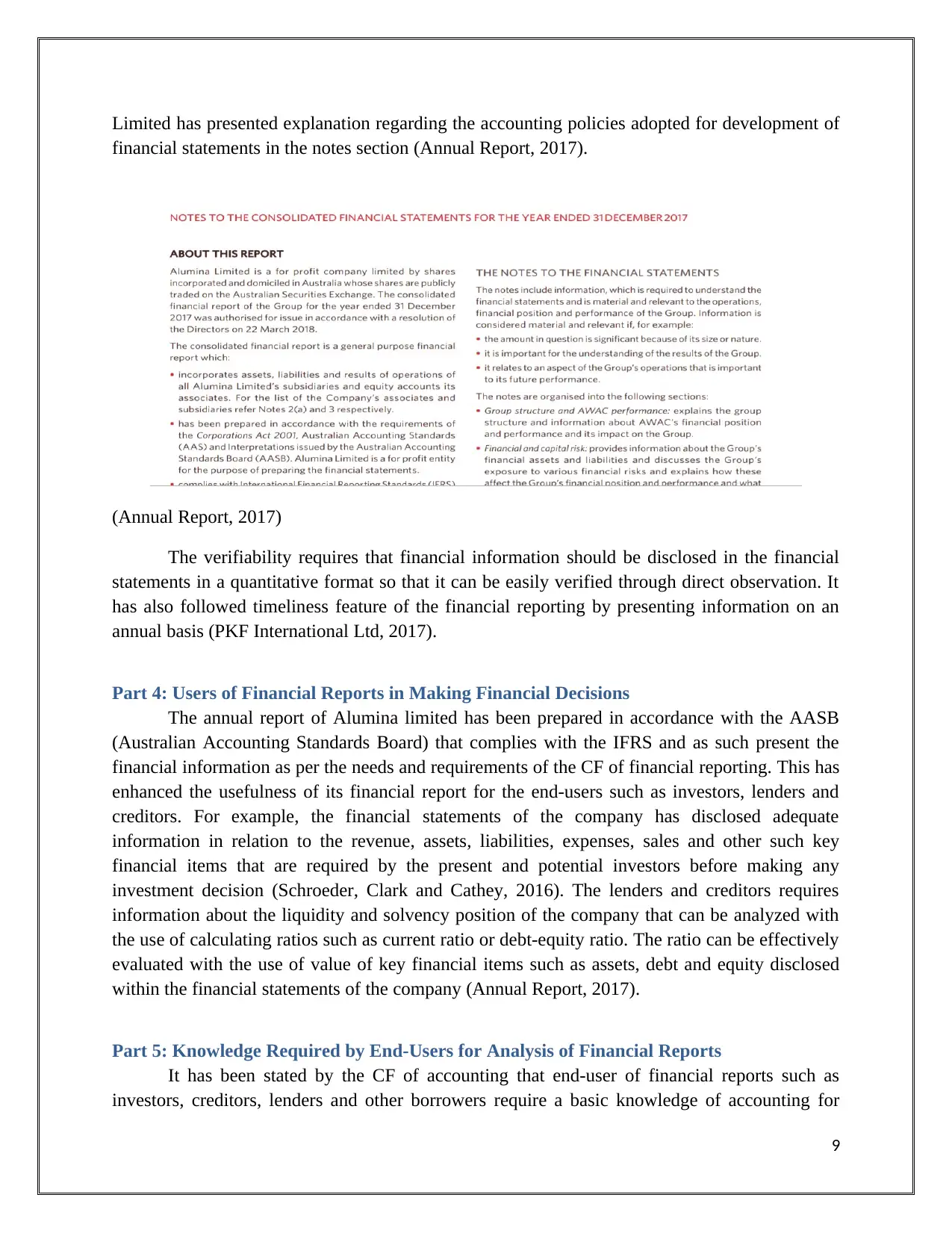
Limited has presented explanation regarding the accounting policies adopted for development of
financial statements in the notes section (Annual Report, 2017).
(Annual Report, 2017)
The verifiability requires that financial information should be disclosed in the financial
statements in a quantitative format so that it can be easily verified through direct observation. It
has also followed timeliness feature of the financial reporting by presenting information on an
annual basis (PKF International Ltd, 2017).
Part 4: Users of Financial Reports in Making Financial Decisions
The annual report of Alumina limited has been prepared in accordance with the AASB
(Australian Accounting Standards Board) that complies with the IFRS and as such present the
financial information as per the needs and requirements of the CF of financial reporting. This has
enhanced the usefulness of its financial report for the end-users such as investors, lenders and
creditors. For example, the financial statements of the company has disclosed adequate
information in relation to the revenue, assets, liabilities, expenses, sales and other such key
financial items that are required by the present and potential investors before making any
investment decision (Schroeder, Clark and Cathey, 2016). The lenders and creditors requires
information about the liquidity and solvency position of the company that can be analyzed with
the use of calculating ratios such as current ratio or debt-equity ratio. The ratio can be effectively
evaluated with the use of value of key financial items such as assets, debt and equity disclosed
within the financial statements of the company (Annual Report, 2017).
Part 5: Knowledge Required by End-Users for Analysis of Financial Reports
It has been stated by the CF of accounting that end-user of financial reports such as
investors, creditors, lenders and other borrowers require a basic knowledge of accounting for
9
financial statements in the notes section (Annual Report, 2017).
(Annual Report, 2017)
The verifiability requires that financial information should be disclosed in the financial
statements in a quantitative format so that it can be easily verified through direct observation. It
has also followed timeliness feature of the financial reporting by presenting information on an
annual basis (PKF International Ltd, 2017).
Part 4: Users of Financial Reports in Making Financial Decisions
The annual report of Alumina limited has been prepared in accordance with the AASB
(Australian Accounting Standards Board) that complies with the IFRS and as such present the
financial information as per the needs and requirements of the CF of financial reporting. This has
enhanced the usefulness of its financial report for the end-users such as investors, lenders and
creditors. For example, the financial statements of the company has disclosed adequate
information in relation to the revenue, assets, liabilities, expenses, sales and other such key
financial items that are required by the present and potential investors before making any
investment decision (Schroeder, Clark and Cathey, 2016). The lenders and creditors requires
information about the liquidity and solvency position of the company that can be analyzed with
the use of calculating ratios such as current ratio or debt-equity ratio. The ratio can be effectively
evaluated with the use of value of key financial items such as assets, debt and equity disclosed
within the financial statements of the company (Annual Report, 2017).
Part 5: Knowledge Required by End-Users for Analysis of Financial Reports
It has been stated by the CF of accounting that end-user of financial reports such as
investors, creditors, lenders and other borrowers require a basic knowledge of accounting for
9
⊘ This is a preview!⊘
Do you want full access?
Subscribe today to unlock all pages.

Trusted by 1+ million students worldwide
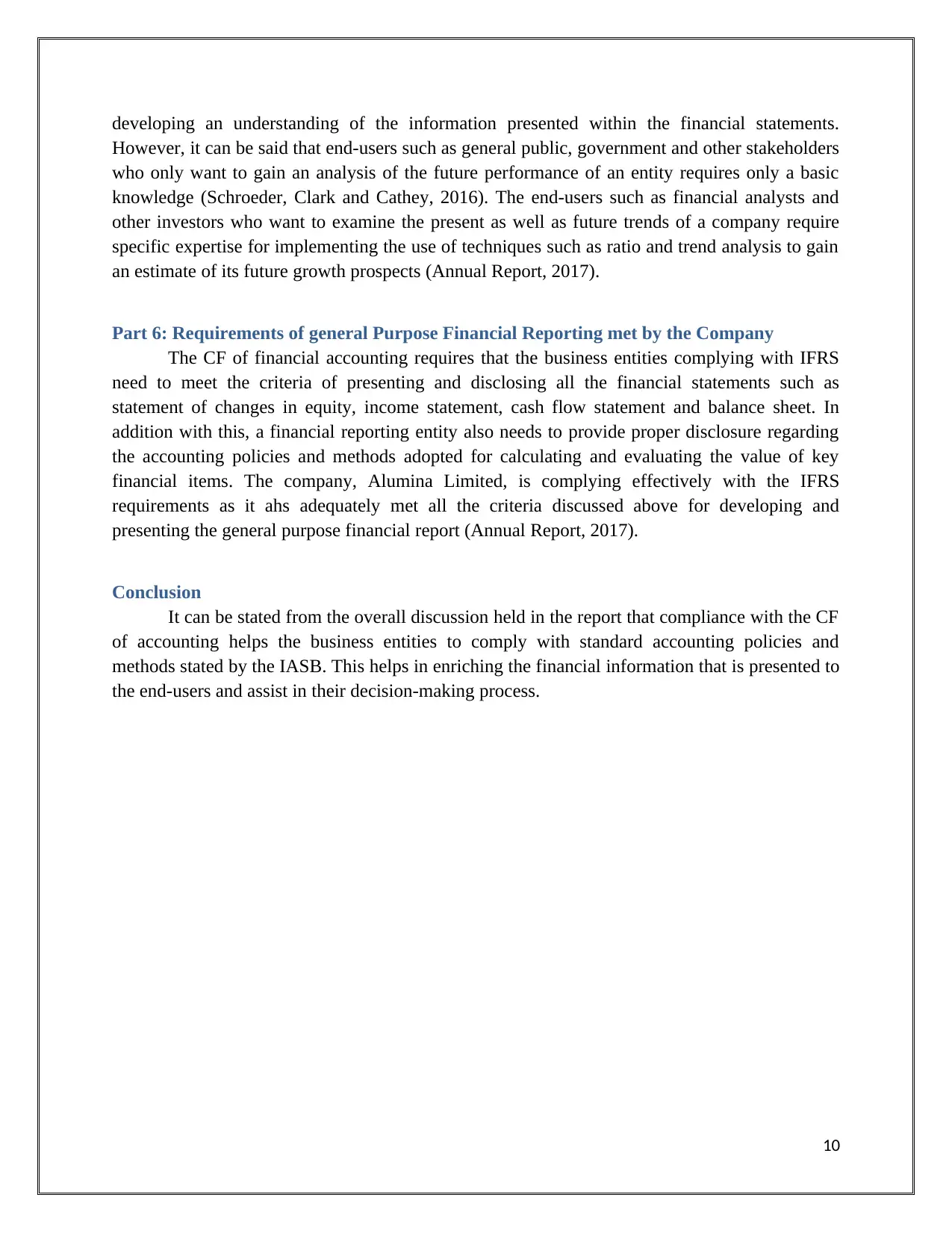
developing an understanding of the information presented within the financial statements.
However, it can be said that end-users such as general public, government and other stakeholders
who only want to gain an analysis of the future performance of an entity requires only a basic
knowledge (Schroeder, Clark and Cathey, 2016). The end-users such as financial analysts and
other investors who want to examine the present as well as future trends of a company require
specific expertise for implementing the use of techniques such as ratio and trend analysis to gain
an estimate of its future growth prospects (Annual Report, 2017).
Part 6: Requirements of general Purpose Financial Reporting met by the Company
The CF of financial accounting requires that the business entities complying with IFRS
need to meet the criteria of presenting and disclosing all the financial statements such as
statement of changes in equity, income statement, cash flow statement and balance sheet. In
addition with this, a financial reporting entity also needs to provide proper disclosure regarding
the accounting policies and methods adopted for calculating and evaluating the value of key
financial items. The company, Alumina Limited, is complying effectively with the IFRS
requirements as it ahs adequately met all the criteria discussed above for developing and
presenting the general purpose financial report (Annual Report, 2017).
Conclusion
It can be stated from the overall discussion held in the report that compliance with the CF
of accounting helps the business entities to comply with standard accounting policies and
methods stated by the IASB. This helps in enriching the financial information that is presented to
the end-users and assist in their decision-making process.
10
However, it can be said that end-users such as general public, government and other stakeholders
who only want to gain an analysis of the future performance of an entity requires only a basic
knowledge (Schroeder, Clark and Cathey, 2016). The end-users such as financial analysts and
other investors who want to examine the present as well as future trends of a company require
specific expertise for implementing the use of techniques such as ratio and trend analysis to gain
an estimate of its future growth prospects (Annual Report, 2017).
Part 6: Requirements of general Purpose Financial Reporting met by the Company
The CF of financial accounting requires that the business entities complying with IFRS
need to meet the criteria of presenting and disclosing all the financial statements such as
statement of changes in equity, income statement, cash flow statement and balance sheet. In
addition with this, a financial reporting entity also needs to provide proper disclosure regarding
the accounting policies and methods adopted for calculating and evaluating the value of key
financial items. The company, Alumina Limited, is complying effectively with the IFRS
requirements as it ahs adequately met all the criteria discussed above for developing and
presenting the general purpose financial report (Annual Report, 2017).
Conclusion
It can be stated from the overall discussion held in the report that compliance with the CF
of accounting helps the business entities to comply with standard accounting policies and
methods stated by the IASB. This helps in enriching the financial information that is presented to
the end-users and assist in their decision-making process.
10
Paraphrase This Document
Need a fresh take? Get an instant paraphrase of this document with our AI Paraphraser
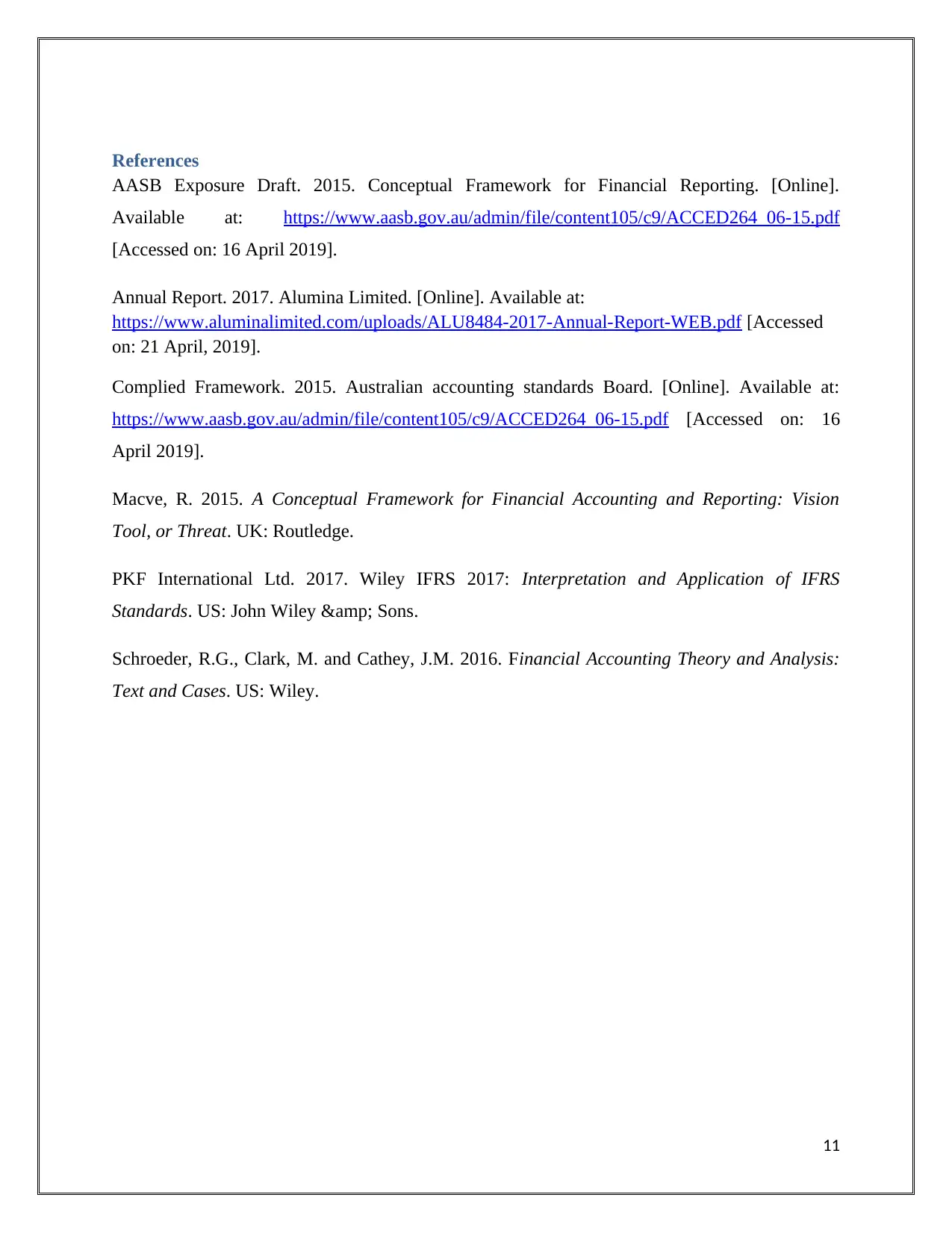
References
AASB Exposure Draft. 2015. Conceptual Framework for Financial Reporting. [Online].
Available at: https://www.aasb.gov.au/admin/file/content105/c9/ACCED264_06-15.pdf
[Accessed on: 16 April 2019].
Annual Report. 2017. Alumina Limited. [Online]. Available at:
https://www.aluminalimited.com/uploads/ALU8484-2017-Annual-Report-WEB.pdf [Accessed
on: 21 April, 2019].
Complied Framework. 2015. Australian accounting standards Board. [Online]. Available at:
https://www.aasb.gov.au/admin/file/content105/c9/ACCED264_06-15.pdf [Accessed on: 16
April 2019].
Macve, R. 2015. A Conceptual Framework for Financial Accounting and Reporting: Vision
Tool, or Threat. UK: Routledge.
PKF International Ltd. 2017. Wiley IFRS 2017: Interpretation and Application of IFRS
Standards. US: John Wiley & Sons.
Schroeder, R.G., Clark, M. and Cathey, J.M. 2016. Financial Accounting Theory and Analysis:
Text and Cases. US: Wiley.
11
AASB Exposure Draft. 2015. Conceptual Framework for Financial Reporting. [Online].
Available at: https://www.aasb.gov.au/admin/file/content105/c9/ACCED264_06-15.pdf
[Accessed on: 16 April 2019].
Annual Report. 2017. Alumina Limited. [Online]. Available at:
https://www.aluminalimited.com/uploads/ALU8484-2017-Annual-Report-WEB.pdf [Accessed
on: 21 April, 2019].
Complied Framework. 2015. Australian accounting standards Board. [Online]. Available at:
https://www.aasb.gov.au/admin/file/content105/c9/ACCED264_06-15.pdf [Accessed on: 16
April 2019].
Macve, R. 2015. A Conceptual Framework for Financial Accounting and Reporting: Vision
Tool, or Threat. UK: Routledge.
PKF International Ltd. 2017. Wiley IFRS 2017: Interpretation and Application of IFRS
Standards. US: John Wiley & Sons.
Schroeder, R.G., Clark, M. and Cathey, J.M. 2016. Financial Accounting Theory and Analysis:
Text and Cases. US: Wiley.
11
1 out of 11
Related Documents
Your All-in-One AI-Powered Toolkit for Academic Success.
+13062052269
info@desklib.com
Available 24*7 on WhatsApp / Email
![[object Object]](/_next/static/media/star-bottom.7253800d.svg)
Unlock your academic potential
Copyright © 2020–2025 A2Z Services. All Rights Reserved. Developed and managed by ZUCOL.





